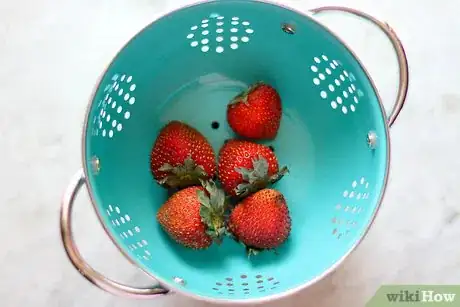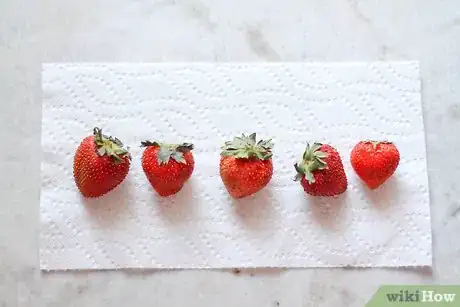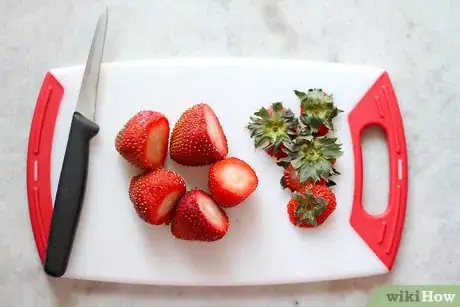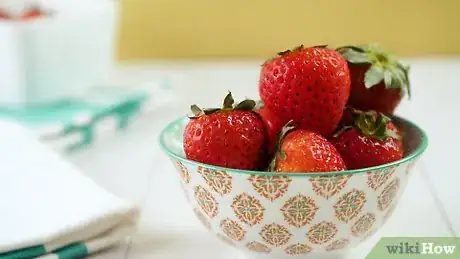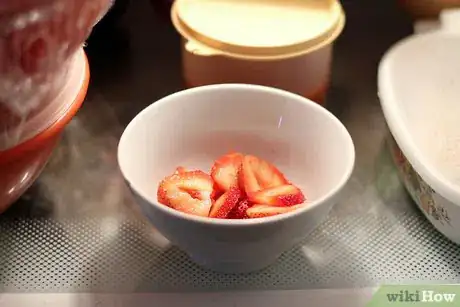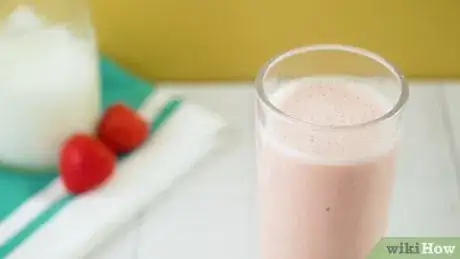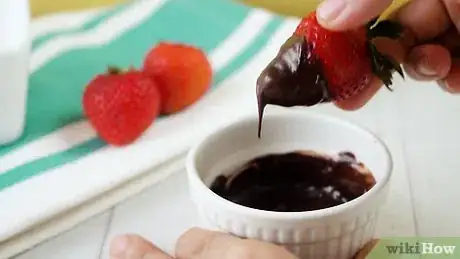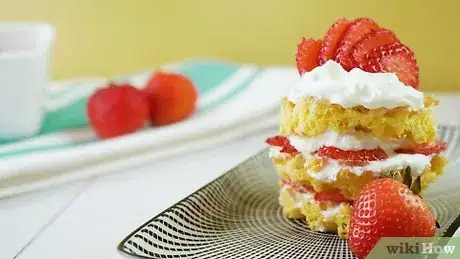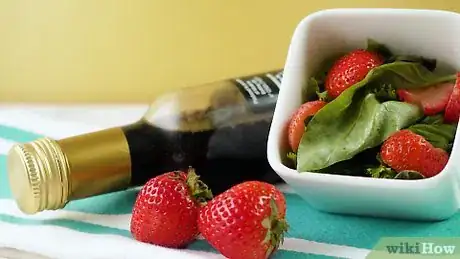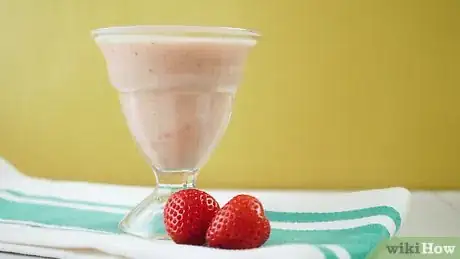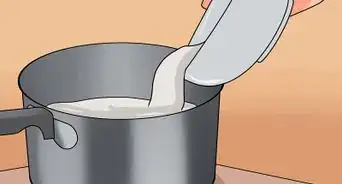This article was co-authored by wikiHow Staff. Our trained team of editors and researchers validate articles for accuracy and comprehensiveness. wikiHow's Content Management Team carefully monitors the work from our editorial staff to ensure that each article is backed by trusted research and meets our high quality standards.
There are 14 references cited in this article, which can be found at the bottom of the page.
The wikiHow Video Team also followed the article's instructions and verified that they work.
This article has been viewed 167,051 times.
Learn more...
Strawberries are a traditional taste of summer. They can be eaten fresh and used in desserts. To save your strawberries for as long as possible, keep them cool and dry in the fridge, washing and hulling them only when you intend to eat them. Add strawberries to your favorite smoothie, pancakes, waffles, or even salad. Or, use them to make a classic dessert like strawberry shortcake or chocolate-dipped strawberries.
Steps
Washing Strawberries
-
1Select bright, fresh looking berries. Avoid shriveled, dried up or moldy berries. Avoid soggy strawberries too, as this means they are past their prime. A good strawberry is firm and shiny.[1]
- Choose organic strawberries, if you can, as non-organic strawberries can be quite pesticide-laden.
- Some cooks believe smaller strawberries have more flavor due to a higher concentration of sugars.
-
2Rinse strawberries under running water when you are ready to eat them. Only rinse strawberries right before you plan to eat them, as washing them will cause them to go bad more quickly. Rub the berries gently under running water to make sure each berry is clean and free of as much soil as possible. Most strawberries sold at the grocery store are fairly clean, so a brief rinsing should do the trick.[2]
- If you plan to freeze your strawberries, wash them first.
- Strawberries can become mushy if they are under water too long. A quicker rinse will help them keep their firm texture.
- Rinse non-organic strawberries more thoroughly and consider using a drop of mild dish soap or white vinegar to clean them.
Advertisement -
3Dry the strawberries thoroughly after washing them. Let the strawberries drain in a colander or place them on a paper towel to soak up any excess water. If you are only rinsing a few strawberries, pat them gently with a towel to dry them more quickly. Drying strawberries after washing them will help keep them from getting mushy.[3]
- The more moisture strawberries soak up, the more mushy the texture will be.
-
4Hull and slice the strawberries right before you want to eat them. Hull the berries by removing the green cap and pale flesh with a paring knife or a strawberry huller. On a fully ripe strawberry, you can hull it by gently pulling on the leaves until the stem comes out. Slice them, if you prefer, by standing them on the flat edge and using a paring knife to cut them in half or smaller.[4]
- The stem of a strawberry keeps it fresher for longer. Only remove it when you are ready to eat the strawberry.
Storing Strawberries
-
1Leave strawberries on the counter if you plan to eat them within the day. Fresh strawberries will last for about 24 hours at room temperature. Rinse and hull strawberries right before you eat them.[5]
- After around 24 hours, strawberries will get moldy at room temperature.
-
2Store strawberries in the refrigerator for up to a week. Store strawberries whole and unwashed for up to 7 days in the fridge. Prepare the strawberries when you are ready to use them.[6]
- Some strawberries will last a little shorter or longer in the fridge. Check the strawberries for mold before using them.
-
3Soak strawberries in a vinegar solution to make them last longer. Fill a glass bowl with a mixture of 1 part white vinegar and 3 parts water. Add the strawberries into the bowl and let them soak for 5 minutes. Rinse and dry the strawberries. Store them in the fridge in a partially covered container lined with a paper towel.[7]
- The vinegar kills spores that form mold on strawberries. Strawberries can last up to a couple of weeks using this method.
- You won't need to rinse your strawberries again when you are ready to eat them if you soak them in vinegar.
-
4Try a heat bath if your berries tend to go bad quickly. Bring a pot of water up to 120 °F (49 °C). Plunge the strawberries into the bath for 30 seconds. Then, take the strawberries out of the water and let them cool and dry on a paper towel. Repack them and store them in the fridge.[8]
- If you frequently buy berries, only to have them go bad the next day in the fridge, try this method.
- You won't need to rinse your strawberries again when you are ready to eat them if you use a heat bath.
-
5Freeze strawberries for up to 6 months. Arrange washed and hulled strawberries on a baking pan lined with parchment paper in a single layer so that the strawberries aren't touching. Freeze them for around 1-4 hours, until they are frozen solid. Remove the frozen strawberries from the baking sheet and place them in freezer-safe storage bags. Put the strawberries back into the freezer for up to 6 months.[9]
- Frozen strawberries are good for smoothies, pies, cobblers, crisps, and compotes.
- To help the strawberries freeze faster, slice them into halves or quarters. It's also much easier to cut fresh strawberries than frozen strawberries.
-
6Buy frozen strawberries if you can't find any fresh. Frozen strawberries have the same nutritional content and flavor as fresh strawberries, but they will lose their texture and become mushy when you defrost them. Typically, they are best for baking and smoothies, as cooking or blending strawberries makes them lose their texture anyway.[10]
- Try adding frozen strawberries to smoothies, oatmeal, or cakes.
- Frozen strawberries are usually good for about 6 months.
Using Strawberries in Recipes
-
1Add sliced, frozen strawberries into smoothies. A strawberry banana smoothie is a classic combination. To make one, blend 1 banana, 2 cups (400 g) of frozen strawberries, 1⁄2 cup (120 mL) of plain yogurt, and 1 cup (240 mL) of milk until the mixture is smooth.[11]
- You can also add in 1 tablespoon (15 mL) or so of honey if the smoothie isn't sweet enough, or 1 tsp (3 g) of chia seeds to thicken and add fiber to the smoothie.
- Add a spoonful of nut butter for more protein.
- You can also use fresh strawberries in smoothies along with 3-4 ice cubes.
-
2Make chocolate dipped strawberries for a fun and popular dessert. Put 2 cups (350 g) of semisweet chocolate chips and 2 tablespoons (30 mL) of coconut oil in the microwave for 30 seconds at a time, stirring between, until the mixture is completely melted and smooth. Dip strawberries into the chocolate and place them on parchment paper. Put them in the fridge to harden for 30 minutes.[12]
- For a variation, try using white chocolate or add sprinkles or nuts while the chocolate is still wet.
-
3Make strawberry shortcake for a summery dessert. To make a quick and easy strawberry shortcake, use a store-bought shortcake. Add sliced strawberries and whipped cream on top of the shortcake.
- To go the extra mile, make the shortcake and the whipped cream by hand.
-
4Add balsamic strawberries to a salad. To make balsamic strawberries, combine 2 tablespoons (30 mL) of balsamic vinegar and 1/4 c (50 g) of sugar to 16 oz (450 g) of strawberries. Mix and let the strawberries sit for around an hour. Add the strawberries to a spinach or kale salad with ingredients like pine nuts, walnuts, goat cheese, or beets.[13]
- You can also add plain, sliced strawberries to a salad.
-
5Try an easy, healthy strawberry sorbet for a frozen treat. To make a quick and easy strawberry sorbet, add about 3 cups (600 g) of frozen strawberries to a blender. Add in 2 tablespoons (30 mL) of honey. Blend until smooth, and add a little warm water if you want a looser texture.[14]
- You can also add different berries, or use maple syrup instead of honey.
-
6Make strawberry yogurt pancakes for a weekend brunch at home. To make the pancakes, mix 2 cups (260 g) of flour, 1 tsp (4 g) of baking powder, 1 tsp (4 g) of baking soda, 1 tsp (4 g) of salt, and 4 tsp (16 g) of sugar. In another bowl, mix 2 lightly beaten eggs with 4 tbsp (60 g) of melted butter, 1 cup (250 g) of vanilla yogurt and 1 1/2 cups (375 mL) of buttermilk. Add the wet ingredients to the dry ingredients. Cook around 1/4 cup (60 mL) of the batter on a griddle at a time. Top with sliced strawberries.[15]
- You can also add the sliced strawberries directly into the pancake mix, if you prefer. Add about 1 cup (200 g).
- Add to the strawberry flavor by using strawberry yogurt instead of plain.
- You can also use frozen strawberries in your pancake batter if you don't have any fresh.
-
7Put a few strawberries in your water for subtle flavor. To make your hydration a little bit more exciting, simply add a few sliced strawberries to your water. Refrigerate the strawberry water for around 6 hours or overnight.[16]
- Try this with sparkling water to add a little carbonation.
-
8Make strawberry jam to spread on your morning toast. In a large bowl, crush 2 pounds (0.91 kg) of strawberries in batches using a wooden spoon. Add the crushed strawberries into a large saucepan with 4 cups (800 g) of white sugar and the juice of one lemon. Stir the mixture over a low heat until it comes to a boil. Keep boiling until the mixture reaches 220 °F (104 °C).[17]
- This recipe will make around 40 fluid ounces (1.2 L) of jam, so it's useful to have at least 3 16-ounce (.5 L) mason jars with lids sterilized and ready to store the jam in.
- This makes an excellent gift if you can't eat all the jam yourself.
Community Q&A
-
QuestionHow long will strawberries last in the fridge?
 Community AnswerThis depends on how fresh/ripe they were when you purchased them, but generally about a week.
Community AnswerThis depends on how fresh/ripe they were when you purchased them, but generally about a week. -
QuestionHow do I keep my strawberries from turning brown? When can I sugar them?
 Community AnswerPut some lemon juice on them. You can sugar before freezing or when you take them out. I like them sugared right when we take them out; I think it tastes more fresh. If you do choose to sugar then freeze, the crystals may freeze and disintegrate.
Community AnswerPut some lemon juice on them. You can sugar before freezing or when you take them out. I like them sugared right when we take them out; I think it tastes more fresh. If you do choose to sugar then freeze, the crystals may freeze and disintegrate. -
QuestionCan strawberries be served with leaves still attached?
 Community AnswerYes. Most people know not to eat them. If they are on a tart, or in something like a pie, or a fruit salad, you would want to remove them, but if they are just on a plate, you should be okay.
Community AnswerYes. Most people know not to eat them. If they are on a tart, or in something like a pie, or a fruit salad, you would want to remove them, but if they are just on a plate, you should be okay.
References
- ↑ https://www.bbcgoodfood.com/glossary/strawberry
- ↑ https://www.bbcgoodfood.com/glossary/strawberry
- ↑ https://www.thekitchn.com/obvious-but-helpful-how-to-prep-strawberries-245020
- ↑ https://www.goodhousekeeping.com/institute/a23967/keep-strawberries-fresh/
- ↑ https://www.thekitchn.com/obvious-but-helpful-how-to-prep-strawberries-245020
- ↑ https://www.thekitchn.com/obvious-but-helpful-how-to-prep-strawberries-245020
- ↑ https://www.thekitchn.com/smart-tip-keep-berries-fresh-longer-with-this-washing-method-172141
- ↑ https://www.nytimes.com/2009/08/26/dining/26curi.html
- ↑ https://www.epicurious.com/expert-advice/how-to-freeze-strawberries-article
- ↑ https://www.thekitchn.com/5-ways-to-cook-with-frozen-strawberries-shop-your-freezer-200553
- ↑ https://www.spendwithpennies.com/strawberry-banana-smoothie/
- ↑ https://www.delish.com/cooking/recipe-ideas/recipes/a58094/how-to-make-chocolate-covered-strawberries/
- ↑ https://www.allrecipes.com/recipe/86390/strawberries-with-balsamic-vinegar/
- ↑ https://www.asweetpeachef.com/strawberry-sorbet/
- ↑ https://www.food.com/recipe/strawberry-yogurt-pancakes-238099
- ↑ https://www.coffeeandquinoa.com/2013/06/strawberry-spa-water/
- ↑ https://www.allrecipes.com/recipe/38410/strawberry-jam/

